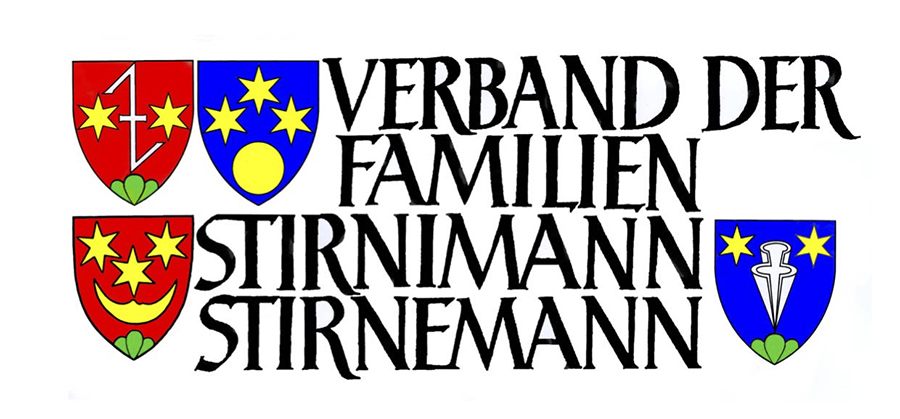

Newsletter No. 28 Ruswil - March 2002
Table of Contents
Foreword 1
The Stirnimann family in Ruswil 2
Rolf Stirnemann, hobby painter 4
Father Jost Stirnimann 5
Forum 7
Miscellaneous 8
Foreword
Dear Relatives and Acquaintances
Dear Members and Friends of our Family Association
"When people become human beings for one another in love again, the sky opens above the earth". The words of Phil Bosman have been invading me since the many terrible events of last year, when some madmen, members of the so-called "human species of reason", have actually managed in a primitive and unbelievable way to invade the "heaven over the earth" for thousands let, again clearer consciousness. At the same time, Phil Bosman provides us with his words a logical recipe against these senseless acts: Become loving people! But can a person who has been denied tenderness and love from birth, who has never experienced basic trust, ever become a loving person? Imagine that there is no human being on this earth who likes you or likes to be sympathetic. An unimaginable thought, because at least your own mother would have to love you and probably also the father. So we can only hope and believe that this idea applies to as few people as possible.
If we as members of our family association are especially interested in our ancestors, our clan and our families, then so for me, this is an expression of the family's sense of security that we have been able to experience through our parents, family members, relatives and acquaintances, and ultimately our ancestors. Let us be thankful for all experienced, loving humanity, which always opens the sky above the earth in the most beautiful colors of life.
It makes sense to express our joy and gratitude in a family meeting. For example, on June 30, 2002, I would like to invite you to the triennial Family Reunion. This year we will meet at the farm Eglisberg in the village Buttisholz and enjoy hospitality in the lounge of the company Huber, Metallbau. This farm is located close to our headquarters in the Rot, Ruswil, which is also the birthplace of Father Jost Stirnimann. By the way, this report has a report dedicated to him. The board has come up with something new for the 11th Family Meeting to let. We decided to open the conference with a varied brunch (breakfast + lunch = brunch, in German "Z'Morgen + z'Mittag"). In general, this Sunday should be uncomplicated and comfortable, so that many opportunities for talks and contacts should be possible. If the weather plays along, the marvelous landscape between the districts of Nottwiler and Ruswilerberg could well invite to a walk with "child and cone". I am already looking forward to many encounters and I ask you to observe the deadline for registration, April 30, 2002. For all non-motorized people a driving opportunity is again organized. Details can be found in the enclosed invitation and the daily program.
Unfortunately, there were sad moments on the board too. In June 2001 Hans Stirnimann-Schenkermayr, the spouse of our esteemed board member and material manager Maria Stirnimann-Schenkermayr unexpectedly died. On behalf of the Board and the whole Family Association, I have condoled Mary and her family.
For professional reasons, our two auditors Josef Stirnemann, Adliswil, and Toni Stirnimann, Lucerne, have made their offices available. I regret the resignations, but we all know that today's professional strain has greatly increased. Thanks to both of you, Josef and Toni, at this point welcome to join in.
Fortunately, we were able to re-fill the office of auditors with Josef Stirnimann-Ulrich, Emmenbrücke, and Thomas Stirnimann-Häfliger, Rothrist. I would like to thank Josef and my twin brother Thomas for the spontaneous commitment. I am glad to know them on our board team.
At the end of 2001, the sky above the earth was very special for me personally, because my wife and I were allowed to welcome our son Valerio as an independent, new earth-citizen.
Finally, I would not miss to thank my board members very warmly. In addition to the property business, we experience many nice and interesting hours at the meetings, which I personally do not want to miss. Even if the work of the board demands some sacrifices in time and is far from self-evident, human encounters and experiences are worth much more than seemingly "lost" time. And when I recall Phil Bosman's words, "the sky over the earth" has always opened up in those moments.
Best regards
The President Beat Stirnimann
The Family Stirnimann in Ruswil
Around 1610, Peter Stirnimann (around 1560–1620), the son of Heinrich and Kunigund Sinner of Luthern, acquired the farm In the Rot in Ruswil, which had around 160 Jucharten. At about the same time, Peter Stirnimann donated a tithe for himself, his wife Adelheid Bircher, his five children Hans, Peter, Hans-Jakob, Maria and Barbara and his mother Kunigund Sinner to the parish church of Sursee, to whose parish the farm In the Rot belonged at that time, for 60 guilders. Peter Stirnimann became the progenitor of a numerous family that also branched out to Buttisholz, Neuenkirch, Nottwil and Ohmstal.
Together with his eldest son Hans (d. 1647) and probably for him, Peter Stirnimann acquired - probably on 1 September 1612 - also the Grissenegg property bordering the farm In the Rot and holding 22 Jucharten. The son Peter (1600–1668) took over the neighboring farm Etzenerlen, which had 170 Jucharten, by marrying in 1624, its heiress Marie Süess. Peter was a juror and judge, i.e. chairman of the village court in Ruswil. The large farmer and civil servant, whose marriage remained childless, made a name for himself through his social convictions and charity. He erected at the Ruswil parish church for that unusual high foundation capital of 1000 guilders -according to today's value approx. 200,000 francs -a tithe for himself, his wife Maria Süess, his parents “and everyone who is of the same family”. He donated the same amount to the poor relief in the parish of Ruswil. After his death, his brother Hans-Jakob (1598–1670) inherited the Etzenerlen farm. Of his three sons Hans (d. 1675) took over his father's farm in the Rot, Sebastian (d. 1679) moved to Etzenerlen, whose farms mainly are owned by the descendants today. The third son named Peter (* 1706) became a monk, with the religious name Jost (Jodok), at the Benedictine abbey of Muri in Freiamt, Aargau. Father Jost left behind a largely Latin diary that records a number of revealing events from the life of his parents and siblings and is an important source of the building history of the Muri monastery church for the years 1695–1697. The brothers Peter (1667–1741) and Leonz (1671–1741), the sons of the aforementioned Hans Stirnimann, were the first to share the farm in the Rot. Peter took over what is now Upper Rot, Leonz what is now Lower Rot. Leonz is today's best-known personality of the seven generations on the farm in the Rot. Around 1705 he had the late Gothic block building taken over from his fathers converted and expanded into today's splendid residential building in the style of the early Baroque. His son, tax manager Peter Stirnimann (1694–1769), increased his property by buying two farms totaling 66.5 Jucharten in the nearby Middle Arig. Of the four sons, the oldest, Joseph (1722–1795), received the Lower Rot farm. Adam (around 1730–1795) acquired the Mittelarig farm, Augustin (around 1731–1805) acquired the Sitenmoos farm in Neuenkirch, Leonz (1733–1808), the youngest, entered the Franciscan monastery in Werthenstein. Father Fortunat, as he was called by his religious name, was a field preacher in a Swiss regiment in France. In 1821 Kaspar (1781–1856), the youngest of the six sons of the aforementioned Joseph Stirnimann, sold Lower Rot after several divisions and buyouts, probably mainly as a result of the severe economic crisis of those years. Ruswil, drawing by Godi Leiser The Stirnimann family belonged to the political, economic and cultural leadership of the former Ruswil office. This is true especially for the Etzenerlen tribe, from which the two official men Peter (1660–1709) and his son Jakob Stirnimann (1683–1754) as well as the official ensign Joseph Stirnimann (1706–1786), the son of the latter, emerged. The Ruswil office, which was incorporated into the Sursee office in 1803, included the present-day communities of Ruswil, Buttisholz, Grosswangen, Menznau, almost all of Menzberg and the Wolhusen and Werthenstein area to the left of the Emme. On September 8, 1974, the association of the Stirnimann families - since 1991 the association of the Stirnimann / Stirnemann families - was founded in Ruswil and now has around 280 members. The vast majority of these come from the families living in the canton of Lucerne (Ruswil, Neuenkirch, Ohmstal, Knutwil, Ettiswil, Gettnau, etc.). But also the Aargau Stirnemanns, who mostly live in Gränichen, are represented in increasing numbers. Since the first few years, descendants of former Swiss emigrants have also joined the association abroad, especially in East Germany and Alsace. The annual newsletter regularly brings historical articles about the ancestors and families of the individual branches and provides information about what is happening in the association. Joseph Stirnimann Literature: Joseph Stirnimann, The Stirnimann Family in the Cantons of Lucerne and Aargau, Beromünster 1971. Claus Niederberger, Der Hof In der Rot near Ruswil and its owners, in: Jahrbuch der Historisches Gesellschaft Lucerne Bd. 7, 1989, p. 45 ff. Newsletter of the Family Association Stirnimann / Stirnemann, Ruswil 1974 ff. Rolf Stirnemann, Hobby Painter At the age of 66, life begins. Udo Jürgens was not wrong with his successful song. But Rolf Stirnemann liked to paint as a boy. Afterwards, as a retired master hairdresser, he scissors, hair dryer and ondulatory staff to the Nagel hangs, he devotes himself to his hobbies with fervor. His first exhibition was in the Italian top restaurant "Gennaro" in Lucerne (August 2000). "No, I never visited a special school," explains Rolf Stirnemann, referring to his impressively strong painting technique, which enables him to bring real sujet objects in form and color to the viewer as if one were - even if only in one Dreaming - have been there before. "However, I'm hereditary in terms of painting. My grandfather painted as well as my father and uncle. Obviously, something must have got stuck ", Rolf Stirnemann weakens modestly. His pictures, however, exude calm. "An inner peace," affirms Stirnemann, "which I, myself as a retiree, primarily find when painting. Then I forget everything around me. However, I think that you should generally set up early on a hobby before the last working day comes. I can not imagine that a retiree without meaningful leisure time activity would only stand behind his wife in the kitchen and criticize her while cooking. “ My wife made me “overblown" The subjects are invariably meticulous snapshots from Western Canada and British Columbia. While we are getting excited about cutting down the tropical rainforests in South America, Rolf Stirnemann's collection, exclusively painted in oil, presents us with a title for many under the title "Memories of Canada” unknown and relatively untouched world. Primeval forest in the northernmost part of America and seascapes, as they may be found in Europe in Finland. Rolf Stirnemann did not add anything to his work and left nothing out: "I painted all the pictures 1: 1, if possible, based on photos taken by my wife Sonja during our visit to Canada. I paint what I see. I can be described as a representative of naturalism. As a hobby painter I also work with watercolor, or I just draw “. 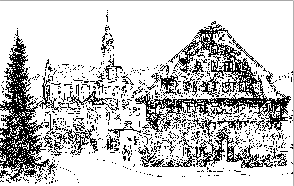
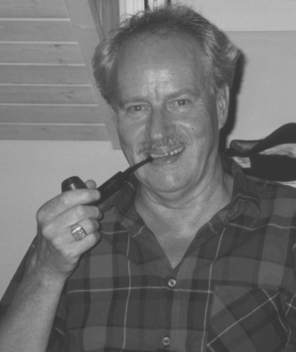
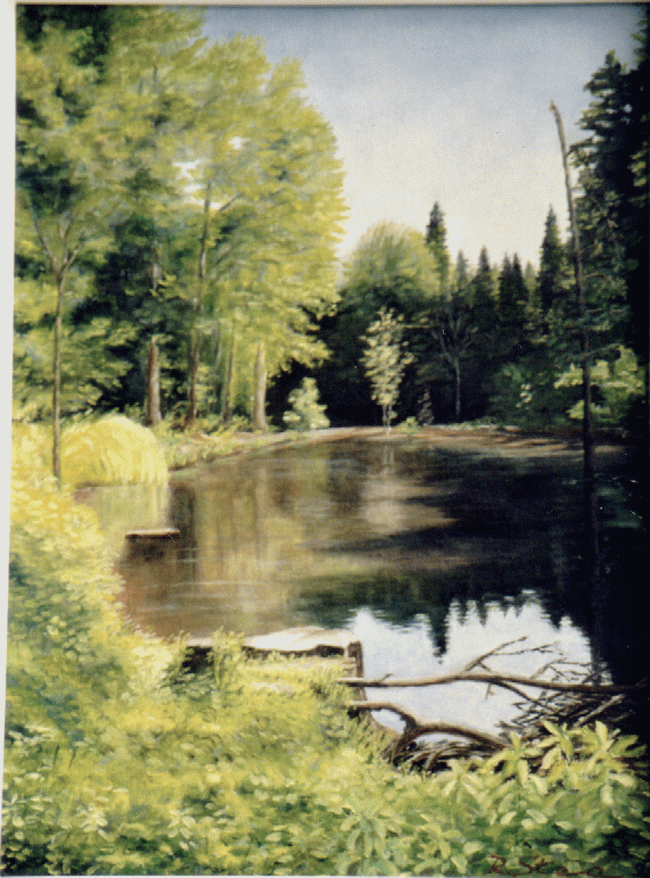
Vernissages Rolf Stirnemann does not like. "Because it's a hobby," he says. "There are others like playing accordion or building model ships". And yet the former Figaro exhibited his paintings in the "Gennaro". "There were two reasons for that: First, my wife had me over the top, and second, Gennaro is my son-in-law.”
"Typical Landscape Sunday Painter”
Rolf Stirnemann gave in to his wife's request, and meanwhile this wish has become his order: for the exhibition "Gennaro" also needed frames for the pictures. "After having a colleague cut my profile, I made it myself, sanded it and painted it over three times", says Rolf Stirnemann, while Ms. Sonja is looking for more exhibition sites. Deep stacking no longer applies in view of the impressive works, and one can also ask oneself the question: "Why did the man at that time even learn hairdressing?”
Meanwhile, son-in-law Gennaro and his father-in-law Rolf already know that the current exhibition "Remembrance of Canada" will be replaced by an exposition on "Autumn" in mid-September with the same artist as a more or less voluntary exponent. He is a typical landscape Sunday painter, says Rolf Stirnemann, with the easel on cliffs or Banks working on the current object according to their mood. "It depends on how often and when the muse kisses me. Sometimes it works, sometimes not ". No new experience for artist types. Although Rolf Stirnemann already sells his works "when someone desperately wants them", he has a hard time dissuading one of his paintings: "The pain of separation is greater than the financial return". Given the quality, the commemoration value and the selling prices, it is really only about symbolic value comparisons.
Hanspeter Léchenne
This report was published in August 2000 in the "Lucerne Week”.
Father Jost Stirnimann
Since the publication of our newsletter, for the first time in 1974, we have regularly reported on the ancestors of the Stirnimann / Stirnemann families in the Lucerne hinterland and in Aargau. These reports are the results of decades of research work by our founder and honorary member Prof. Dr. med. Joseph Stirnimann. - In the future we will inform you, in several episodes, about the contents of the diaries of our namesake Father Jost Stirnimann. The original of this diary is in the archives of the College Sarnen. The transcription and translation took place on our behalf by Bernd Klesmann, Zurich. - Below is a short biography of Father Jost Stirnimann and some explanations about his diary.
Peter, as he was called with his captures, saw the light of day in our family's oldest ancestral home in Rot in Ruswil as the third son of Hans-Jakob Stirnimann and Barbara Bucher. Of the two brothers, Sebastian, the older, patrician court in the Rot, Hans, the younger, took over the farm, which was inherited by Uncle Peter Stirnimann in neighboring Etzenerlen 170 Jucharten. Peter, the brother of the two, became, as mentioned, a monk of the Benedictine Abbey of Muri. Peter made his profession on March 21, 1663 under the monastic name Jost (Jodocus, Jodok). His personally written profession certificate impresses with its magnificent writing. On the day before the profession the brothers "Sebastian and Hans Stirnenmann of Etzenerlen and in the Rot Lucerner Herschaft" assure the novice the paternal and maternal inheritance in the amount of 5,000 gulden, which will be given to the monastery in "good, annealable, secure "Sebastian and Hans Stirnimann further promise that they would worship their brother, if he had received the priestly dignity of God by the grace of God, and worship at the time of his first holy test a church ornament from a robe or silver-gobbled chalice and zuegeben ".- This" Birth and Purchase Letter "is dated 20.3.1673 and bears the signatures and seals of the two brothers, Johann Melchior Underfinger, Helper to Ruswil, the new official Johannes Wüöst and the old Amtsweibels and Pannermeister’s Office Ruswil Hans Jost Hueber.
The list of the Gülten, which the brothers Sebastian and Hans Stirnimann handed over to the monastery, is preserved and gives valuable information about the financial circumstances and connections of the family. The document came with the abolition of the monastery Muri in the Aargauische national archives in Aarau (monastery Muri, No. 6084, folder Q III). The purchase price of 5000 guilders corresponds to today's currency of a round million Swiss francs. For centuries this would be by far the highest dowry a novice brought to Muri Monastery. This sum, and that the relatives gave him a valuable chalice for the primate, was noted as an obvious great rarity or exception even in the official heraldic book of the abbey of Muri in the coat of arms of P. Jost Stirnimann. The chronicler of the Abbey of Muri, P. Leodegar Mayer, also mentions the extraordinary high dowry of our novice in his monastic history and adds that he was "of a peasant but very rich race”.
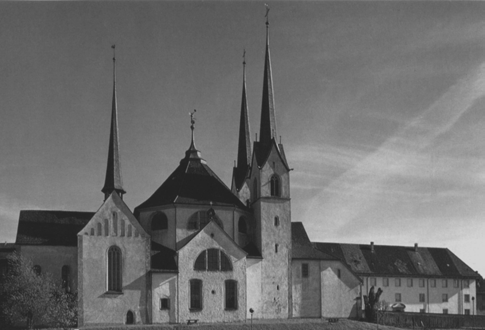
Muri: Monestary Church St. Martin 17th century
Father Jost was appointed by the papal nuncio Lucerne was ordained a deacon on 29.2.1667 and ordained a priest on 4.6.1678; on the following 29th of June he celebrated his first Mass Mass in Muri in the presence of his relatives. Father Jost held the position of corn-master (Granarius) in the monastery, as such he took it - it was the time of the natural economy - contrary to the levies of the monastic farms and had the supervision of the grain magazines. P. Jost died after prolonged "Siechtum" on 28.12.1706.
The unique, lasting merit of Father Jost represents the diary he has left us (Kloster-Archiv Muri-Gries, Kollegium Sarnen, MS 399, Pp 4o P. Jodoc Stirnemann ", Annale breve" 1654-1706). Before 1800, diaries are a great rarity. The fact that the diary of Father Jost is written in a skillful, indeed extremely beautiful Latin lends it a special value; only individual, mostly smaller sections are written in German. Father Jost begins his record by providing information about his birth and background. This introduction reads in German translation as follows:
"I was born in the year 1654 on the 25th of February by the married couple Johann Jakob Stirnenman and Barbara Buocherin, who lived in the parish of Sursee, in the so-called Weiler (villa) Roth, and was baptized in the parish church in Buttisholz by Johann Konrad Lüpert or Lüttert, who was pastor there at the time. Sponsors were Peter Meyer from the so-called Weiler (villa) Mittel arig and Elisabetha Heini from the so-called Weiler (villa) Underarig “.
Father Jost records in his diary, along with his personal observations and thoughts, mainly the memorable events of the monastery and its inhabitants. In the years 1695/97 he closely follows the progress of the construction work on the present-day monastery church. Father Jost's journal is considered to be the main source of the architectural history of this important ecclesiastical central building.
But our family is also indebted to Father Jost, whose diary contains a wealth of news about joys and sorrows and worthwhile events in the lives of his siblings and relatives, with whom the religious remained closely associated.
From the writing "Stammtafel der Stirnimann" of the siblings Stirnimann, Studen, Nottwil by Prof. Dr. med. Joseph Stirnimann.
FORUM
Recently, the reprint of the complete edition of all newsletters from 1974 to 2000 announced in the last newsletter has been published. The volume comprises 300 pages, with a total of 65 graphics / photos, 15 of which are multicolored.
The content mainly comprises the research results of our founding fathers of Ruswil and Neuenkirch by our founding member Prof. Dr. med. Joseph Stirnimann.
The selling price (cost price) is Fr. 45.-, without postage and packaging.
At the same time as the reprint of our newsletter, our member Josef Stirnimann-Greber von Rothenburg has compiled a list of keywords for the mentioned circulars. It is especially for those who want to do themselves with the family research, creating family trees, family chronicles, etc.
The selling price (cost price) is Fr. 8.-, without postage and packaging.
The two volumes can be obtained for the first time on the occasion of the next family meeting at the farm Eglisberg, on June 30, 2002. Furthermore, on this occasion, the previously available fonts are offered. They are:
The chronicle "The family Stirnimann in the cantons of Lucerne and Aargau" by Prof. dr. Joseph Stirnimann (Helyas publishing house, Beromünster 1973) CHF 15 .—
The Farmhouse Under Red in Ruswil (reprint from the Yearbook of the Historical Society Lucerne, 1989, Volume 7) CHF 15 .--